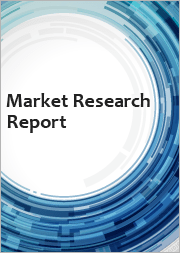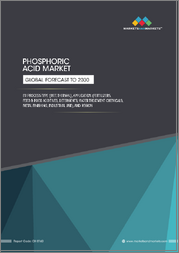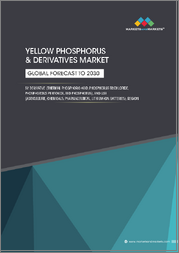
|
시장보고서
상품코드
1627603
인산 시장 : 예측(2025-2030년)Phosphoric Acid Market - Forecasts from 2025 to 2030 |
||||||
인산 시장은 연평균 4.79%의 CAGR로 성장하여 2025년 532억 5,700만 달러에서 2030년에는 642억 1,400만 달러에 달할 것으로 예상됩니다.
인산은 무기산의 일종으로 주로 인광석에서 얻어집니다. 이 산은 무색, 무취, 무독성입니다. 인산은 종종 비휘발성 결정성 액체로 간주됩니다. 인산은 비료 제조, 식품 및 음료 첨가물, 의약 용도 등 다양한 용도로 사용됩니다. 이 시장의 주요 원동력은 세계 인구의 지속적인 증가로 인한 세계 식량 수요의 확대와 농업 생산량의 급격한 증가입니다. 특히 비료는 비료 제조에서 인산의 주요 용도 중 하나입니다.
또한, 가공 식품 및 음료에 인산을 광범위하게 적용하여 맛을 향상시키는 첨가제 및 가공 식품 및 음료 세계 시장 확대는 향후 5년 동안 이 시장의 성장을 촉진하는 중요한 요소입니다.
- World Integrated Trade Solution에 따르면 2021년 인산 및 폴리인산의 상위 수출국은 모로코가 21억 570만Kg으로 1위, 요르단이 5억 7,303만 1,000Kg으로 2위, 중국이 4억 9,436만 2,120달러 상당을 수출한 것으로 나타났습니다. 그리고 세네갈과 미국은 각각 4억 7,843만 5,000Kg과 4억 9,988만 5,000Kg을 수출하고 있습니다.
- 2022년 8월, 인도는 인산이암모늄(DAP)의 자급자족을 발표하고 세네갈에서 채굴하고 인도에서 10LMT의 DAP와 NPK를 생산하는 DAP를 생산할 것이라고 발표했습니다. 인도 정부는 인도 비료 회사의 공급망을 지원하고 있습니다.
인산 시장 촉진요인
- 세계 식량 수요로 인한 비료 사용량 증가
인산 수요가 지속적으로 증가하는 주요 요인 중 하나는 세계 식량 수요의 증가입니다. 동시에 식량 수요의 증가에 따라 비료도 전 세계적으로 증가하고 있습니다.
선진국과 신흥 경제국 모두 인구가 증가하고 도시 인구가 크게 증가하고 있는 것이 세계 식량 수요 증가를 촉진하는 주요 요인입니다. 유엔에 따르면 세계 인구는 2050년까지 97억 명에 달할 것으로 예상됩니다.
인구의 증가는 한정된 토지 자원에 대한 압력을 증가시키고 있습니다. 따라서 한정된 자원으로 더 많은 생산량을 확보해야 합니다. 이 때문에 농부들은 생산량을 늘리려는 경향이 강해지고 있습니다.
그러나 산업화와 도시화로 인해 농지 확대는 상대적으로 어려운 것으로 여겨지고 있습니다. 이 때문에 도시형 농업의 이용이 증가하고, 작물의 생육을 향상시키기 위해 필요한 비료 및 기타 영양소의 채택이 증가하고 있습니다. 따라서 비료 생산용 인산 수요 형성에 중요한 역할을 하고 있습니다.
인산 시장의 지리적 전망
- 인산 시장은 전 세계 5개 지역으로 구분됩니다.
지역별로는 북미, 남미, 유럽, 중동 및 아프리카, 아시아태평양으로 구분됩니다. 아시아태평양은 중국, 일본, 인도, 한국 등 주요 경제국들이 주도하고 있습니다. 급성장하고 있는 신흥국 중에는 아세안 국가 등 이 지역의 국가들도 있습니다.
아시아태평양은 DAP 비료 제조에 대한 사용 증가로 인해 인산에서 가장 빠른 성장이 예상됩니다. 북미는 화학 산업에서 인산이 많이 사용되기 때문에 인산의 시장 점유율이 높을 것으로 예상됩니다.
이 보고서를 구매해야 하는 이유
- 통찰력 있는 분석 : 고객 부문, 정부 정책 및 사회경제적 요인, 소비자 선호도, 산업별, 기타 하위 부문에 초점을 맞추고 주요 지역뿐만 아니라 신흥 지역까지 포괄하는 상세한 시장 인사이트를 얻을 수 있습니다.
- 경쟁 상황 : 세계 주요 기업들이 채택하고 있는 전략적 전략을 이해하고, 적절한 전략을 통한 시장 침투 가능성을 파악할 수 있습니다.
- 시장 동향과 촉진요인 : 역동적인 요인과 매우 중요한 시장 동향, 그리고 이들이 향후 시장 발전을 어떻게 형성할 것인지에 대해 알아봅니다.
- 실행 가능한 제안 : 역동적인 환경 속에서 새로운 비즈니스 스트림과 수익을 발굴하기 위한 전략적 의사결정을 내릴 수 있도록 인사이트를 활용합니다.
- 다양한 사용자에 대응 : 스타트업, 연구기관, 컨설턴트, 중소기업, 대기업에 유익하고 비용 효율적입니다.
어떤 용도로 사용되는가?
산업 및 시장 인사이트, 사업 기회 평가, 제품 수요 예측, 시장 진입 전략, 지리적 확장, 설비 투자 결정, 규제 프레임워크 및 영향, 신제품 개발, 경쟁의 영향
조사 범위
- 2022-2030년 실적 데이터 및 예측
- 성장 기회, 도전과제, 공급망 전망, 규제 프레임워크, 고객 행동, 트렌드 분석
- 경쟁사 포지셔닝, 전략 및 시장 점유율 분석
- 부문 및 국가를 포함한 지역별 매출 성장 및 예측 분석
- 기업 프로파일링(전략, 제품, 재무상태, 주요 발전 등)
목차
제1장 소개
- 시장 개요
- 시장 정의
- 조사 범위
- 시장 세분화
- 통화
- 가정
- 기준 연도와 예측 연도 타임라인
- 이해관계자에 대한 주요 이점
제2장 조사 방법
- 조사 설계
- 조사 과정
제3장 주요 요약
- 주요 조사 결과
- 애널리스트의 견해
제4장 시장 역학
- 시장 성장 촉진요인
- 식량 수요에 대한 비료 사용량이 세계적으로 증가
- 식품 및 음료 업계에서의 사용이 증가
- 비누·세제 제조 수요 증가
- 시장 성장 억제요인
- 제조에 관한 엄격한 규제상 과제
- Porter's Five Forces 분석
- 업계 밸류체인 분석
제5장 인산 시장 : 용도별
- 소개
- 비료
- 식품 및 음료
- 제약
- 기타
제6장 인산 시장 : 프로세스별
- 소개
- 웨트 프로세스
- 서멀 프로세스
제7장 인산 시장 : 지역별
- 세계 개요
- 북미
- 미국
- 캐나다
- 멕시코
- 남미
- 브라질
- 아르헨티나
- 기타 남미
- 유럽
- 영국
- 독일
- 프랑스
- 이탈리아
- 스페인
- 기타 유럽
- 중동 및 아프리카
- 사우디아라비아
- 아랍에미리트
- 기타 중동 및 아프리카
- 아시아태평양
- 중국
- 인도
- 일본
- 한국
- 대만
- 태국
- 인도네시아
- 기타 아시아태평양
제8장 경쟁 환경과 분석
- 주요 기업과 전략 분석
- 시장 점유율 분석
- 합병, 인수, 합의, 협업
- 경쟁 대시보드
제9장 기업 개요
- OCP Group
- novaphos corporation
- Nutrien Ltd.
- Aditya Birla Chemicals(India) Limited
- Prayon
- PhosAgro Group
- Ma'aden
- Agropolychim
- Spectrum Chemical Manufacturing Corp
- ICL Fertilizers
- Arkema Group
- DesmetBallestra
The phosphoric acid market is expected to grow at a CAGR of 4.79%, reaching a market size of US$64.214 billion in 2030 from US$53.257 billion in 2025.
Phosphoric acid is a type of inorganic acid that is primarily derived from phosphate rocks. This acid is colorless, odorless, and non-toxic. Phosphoric acid is often considered a non-volatile and crystalline liquid. Phosphoric acid has wide applications, including fertilizer production, as an additive in food and beverages, and some uses in pharmaceutical applications. This market is primarily driven by the globally growing demand for food due to the constantly increasing global population, which has led to an upsurge in agricultural output. Fertilizers are one of the major applications of phosphoric acid in fertilizer manufacturing, among others.
Additionally, the wide application of phosphoric acid in processed food and beverages as an additive for enhancing taste and the globally growing market for processed foods and beverages is also a key factor boosting this market's growth during the next five years.
- According to World Integrated Trade Solution, in 2021, the top exporters of Phosphoric acid and polyphosphoric acids are Morocco being at the top with 2,105,700,000 Kg, Jordan exporting 573,031,000 Kg, China exporting worth $494,362.12K, Senegal, and the United States exported 478,435,000 Kg and 499,885,000 Kg, respectively.
- In August 2022, India announced to become self-sufficient in Diammonium Phosphate (DAP), mining in Senegal, and production of DAP that would be done in India with 10 LMT DAP and NPK to be manufactured. The government of India has been supporting the Indian fertilizer companies in to supply chain.
Phosphoric acid market drivers
- Globally growing fertilizer usage for food demand
One of the prime factors supplementing the constantly increasing demand for phosphoric acid is the globally growing food demand. Simultaneously, with the growing demand for food, fertilizers have also increased globally.
The growing population and significant growth in the urban population in both developed and developing economies are key factors bolstering the increasing food demand globally. According to the United Nations, the global population is expected to reach 9.7 billion by 2050.
The growing population is increasing the pressure on limited available land resources. Thus, with limited resources, more output is required. This has increased the propensity of farmers toward an increasing production output.
However, due to industrialization and urbanization, the expansion of agricultural land is considered comparatively tougher. This has led to an increased usage of urban farming practices, which further leads to an increase in the adoption of fertilizers and other nutrients required for enhancing crop growth. Thus playing a significant role in shaping the demand for phosphoric acid for fertilizer production.
Phosphoric acid market geographical outlook
- The phosphoric acid market is segmented into five regions worldwide
By geography, the market is segmented into North America, South America, Europe, the Middle East and Africa, and Asia Pacific. The major economies like China, Japan, India, and South Korea dominate the Asia-Pacific region. Some of the fastest-growing emerging economies are from this region, such as ASEAN countries.
The Asia Pacific region is expected to see the fastest growth in phosphoric acid due to increasing applications in the manufacturing of DAP Fertiliser. North America is expected to have a significant market share for phosphoric acid due to its major utilization in the chemical industry.
Reasons for buying this report:-
- Insightful Analysis: Gain detailed market insights covering major as well as emerging geographical regions, focusing on customer segments, government policies and socio-economic factors, consumer preferences, industry verticals, other sub- segments.
- Competitive Landscape: Understand the strategic maneuvers employed by key players globally to understand possible market penetration with the correct strategy.
- Market Drivers & Future Trends: Explore the dynamic factors and pivotal market trends and how they will shape up future market developments.
- Actionable Recommendations: Utilize the insights to exercise strategic decision to uncover new business streams and revenues in a dynamic environment.
- Caters to a Wide Audience: Beneficial and cost-effective for startups, research institutions, consultants, SMEs, and large enterprises.
What do businesses use our reports for?
Industry and Market Insights, Opportunity Assessment, Product Demand Forecasting, Market Entry Strategy, Geographical Expansion, Capital Investment Decisions, Regulatory Framework & Implications, New Product Development, Competitive Intelligence
Report Coverage:
- Historical data & forecasts from 2022 to 2030
- Growth Opportunities, Challenges, Supply Chain Outlook, Regulatory Framework, Customer Behaviour, and Trend Analysis
- Competitive Positioning, Strategies, and Market Share Analysis
- Revenue Growth and Forecast Assessment of segments and regions including countries
- Company Profiling (Strategies, Products, Financial Information, and Key Developments among others)
The phosphoric acid market is segmented and analyzed as follows:
By Application
- Fertilizers
- Food and Beverages
- Pharmaceutical
- Others
By Process
- Wet Process
- Thermal Process
By Geography
- North America
- USA
- Canada
- Mexico
- South America
- Brazil
- Argentina
- Rest of South America
- Europe
- United Kingdom
- Germany
- France
- Italy
- Spain
- Rest of Europe
- Middle East and Africa
- Saudi Arabia
- UAE
- Rest of the Middle East and Africa
- Asia Pacific
- China
- India
- Japan
- South Korea
- Taiwan
- Thailand
- Indonesia
- Rest of Asia-Pacific
TABLE OF CONTENTS
1. INTRODUCTION
- 1.1. Market Overview
- 1.2. Market Definition
- 1.3. Scope of the Study
- 1.4. Market Segmentation
- 1.5. Currency
- 1.6. Assumptions
- 1.7. Base and Forecast Years Timeline
- 1.8. Key benefits for the stakeholders
2. RESEARCH METHODOLOGY
- 2.1. Research Design
- 2.2. Research Process
3. EXECUTIVE SUMMARY
- 3.1. Key Findings
- 3.2. Analyst View
4. MARKET DYNAMICS
- 4.1. Market Drivers
- 4.1.1. Globally growing fertilizers usage for food demand
- 4.1.2. Increasing usage in the food and beverage industry
- 4.1.3. Increased demand for soaps and detergents manufacturing
- 4.2. Market Restraints
- 4.2.1. Strict regulatory challenges regarding manufacturing
- 4.3. Porter's Five Forces Analysis
- 4.3.1. Bargaining Power of Suppliers
- 4.3.2. Bargaining Power of Buyers
- 4.3.3. The Threat of New Entrants
- 4.3.4. Threat of Substitutes
- 4.3.5. Competitive Rivalry in the Industry
- 4.4. Industry Value Chain Analysis
5. PHOSPHORIC ACID MARKET BY APPLICATION
- 5.1. Introduction
- 5.2. Fertilizers
- 5.3. Food And Beverages
- 5.4. Pharmaceutical
- 5.5. Others
6. PHOSPHORIC ACID MARKET BY PROCESS
- 6.1. Introduction
- 6.2. Wet Process
- 6.3. Thermal Process
7. PHOSPHORIC ACID MARKET BY GEOGRAPHY
- 7.1. Global Overview
- 7.2. North America
- 7.2.1. United States
- 7.2.2. Canada
- 7.2.3. Mexico
- 7.3. South America
- 7.3.1. Brazil
- 7.3.2. Argentina
- 7.3.3. Rest of South America
- 7.4. Europe
- 7.4.1. United Kingdom
- 7.4.2. Germany
- 7.4.3. France
- 7.4.4. Italy
- 7.4.5. Spain
- 7.4.6. Rest of Europe
- 7.5. Middle East and Africa
- 7.5.1. Saudi Arabia
- 7.5.2. United Arab Emirates
- 7.5.3. Rest of the Middle East and Africa
- 7.6. Asia-Pacific
- 7.6.1. China
- 7.6.2. India
- 7.6.3. Japan
- 7.6.4. South Korea
- 7.6.5. Taiwan
- 7.6.6. Thailand
- 7.6.7. Indonesia
- 7.6.8. Rest of Asia-Pacific
8. COMPETITIVE ENVIRONMENT AND ANALYSIS
- 8.1. Major Players and Strategy Analysis
- 8.2. Market Share Analysis
- 8.3. Mergers, Acquisitions, Agreements, and Collaborations
- 8.4. Competitive Dashboard
9. COMPANY PROFILES
- 9.1. OCP Group
- 9.2. novaphos corporation
- 9.3. Nutrien Ltd.
- 9.4. Aditya Birla Chemicals (India) Limited
- 9.5. Prayon
- 9.6. PhosAgro Group
- 9.7. Ma'aden
- 9.8. Agropolychim
- 9.9. Spectrum Chemical Manufacturing Corp
- 9.10. ICL Fertilizers
- 9.11. Arkema Group
- 9.12. DesmetBallestra



















